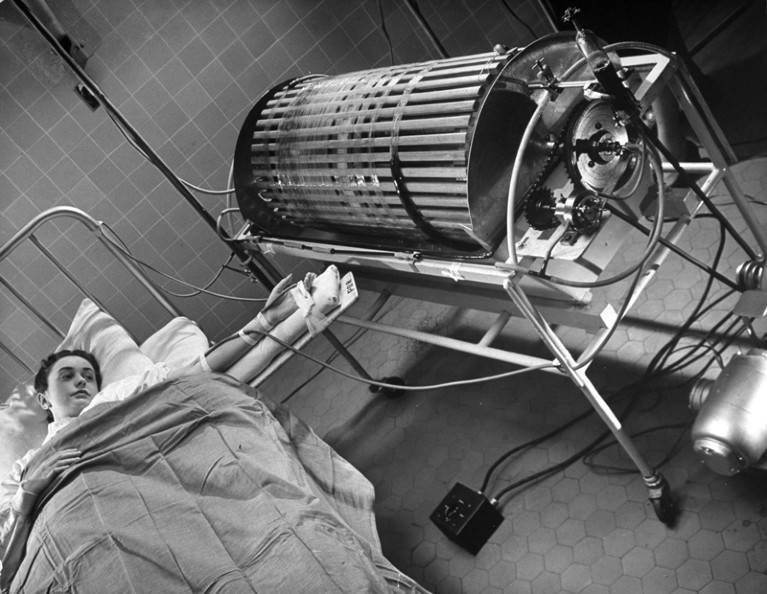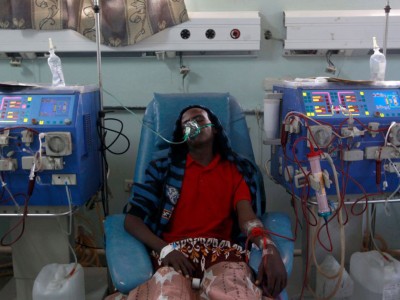
Early dialysis machines made use of large rotating drums. Now a new generation of researchers must make them more portable and less resource-intensiveCredit: Fritz Goro/LIFE Picture Collection/Getty
Dialysis almost immediately saved lives when it was invented in the first half of the twentieth century to treat kidney disease by safely accessing a patient’s blood supply and filtering toxins normally removed by the kidneys.
The original dialysis machine, a rudimentary contraption invented by physician Willem Kolff in the early 1940s, was made from cellophane tubes and a wooden drum. Although today’s machines are manufactured industrially, operating technologies have changed little since the 1960s. And that, as we report in a Feature on page 186, is a problem.
The World Health Organization estimates that, each year, around 1.2 million people worldwide die from kidney failure. This is partly a result of the number of people with high blood pressure and diabetes, which strain and damage the kidneys. But a combination of dialysis technology’s practical limitations and affordability also means that fewer than half of the people who need treatment can access it.
How artificial kidneys and miniaturized dialysis could save millions of lives
In Africa, just 16% of people with kidney disease get dialysis, and even fewer can sustain the cost of treatment for more than a few months. In the United States, where dialysis can cost up to US$91,000 per patient per year, fewer than half of those on the most common form of dialysis survive for more than five years from the onset of kidney failure.
A fundamental problem is that dialysis involves connecting patients to machines that can weigh more than 100 kilograms. For most people, that necessitates regular visits to a hospital or dialysis clinic. A typical treatment regime can take 12 hours, spread over 3 weekly sessions that see toxins filtered from the blood and levels of various salts and minerals recalibrated. For patients, this is an ordeal that is both energy-sapping and time-consuming.
Dialysis also consumes resources. Between 120 and 240 litres of filtered water are needed for each 4-hour session. By one estimate, the annual requirements of the dialysis provided around the world include more than 156 billion litres of water and roughly 1.62 billion kilowatt hours of power — roughly equivalent to the electricity needed to power a small European city for a year. Dialysis also generates some 625,000 tonnes of plastic waste.
Solutions include making dialysis more portable — so that it can be carried out at home or on the move — and finding ways to do it with less water and power. This would be of particular benefit to patients in developing countries.
Promising technologies are being developed to make the machines smaller and more portable. But it is not clear whether these will reach many of those who need them. Despite the clear need for innovation, research funding is low. Last year, the US government and the American Society of Nephrology announced a plan to raise $250 million over 5 years for research. This is welcome, but so far the collaboration, called Kidney X, has disbursed only $1.1 million in grants.
The reality is that chronic kidney disease needs the kind of coordinated global effort, involving funders, researchers and patient groups, that some other conditions attract. Together, these groups must support more research into the mechanisms that underlie kidney disease, and approaches to prevent its development and progression.
At the same time, countries could encourage patients’ family members to consider kidney donation. On average, transplant patients live longer than do those on dialysis — reducing the heavy health and economic burdens of this neglected killer.

 How artificial kidneys and miniaturized dialysis could save millions of lives
How artificial kidneys and miniaturized dialysis could save millions of lives
 Scientists in Pakistan and Sri Lanka bet their futures on China
Scientists in Pakistan and Sri Lanka bet their futures on China







